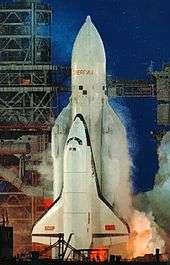Buran (spacecraft)
| Buran Буран | |
|---|---|
|
Orbiter 1K1 at an airshow at Le Bourget in 1989 | |
| Country | Soviet Union |
| Named after | "Snowstorm"[1] |
| Status | Destroyed in a 2002 hangar collapse[2] |
| First flight | 15 November 1988[1] |
| Last flight | 15 November 1988[1] |
| Number of missions | 1[1] |
| Crew members | 0[1] |
| Time spent in space | 3 hours, 36 minutes |
| Number of orbits | 2[1] |
Buran (Russian: Бура́н, IPA: [bʊˈran], Snowstorm or Blizzard) was the first spaceplane to be produced as part of the Soviet/Russian Buran programme. It carried the GRAU index serial number 11F35 K1 and is – depending on the source – also known as OK-1K1, Orbiter K1, OK 1.01 or Shuttle 1.01. Besides describing the first operational Soviet/Russian shuttle orbiter, "Buran" was also the designation for the whole Soviet/Russian space shuttle project.
OK-1K1 completed one unmanned spaceflight in 1988, and was destroyed in 2002 when the hangar it was stored in collapsed.[3] It remains the only Soviet reusable spacecraft to be launched into space. The Buran-class orbiters used the expendable Energia rocket, a class of super heavy-lift launch vehicle.
Construction
The construction of the Buran-class space shuttle orbiters began in 1980, and by 1984 the first full-scale orbiter was rolled out. Construction of a second orbiter (OK-1K2, informally known as "Ptichka") started in 1988. The Buran programme was officially cancelled in 1993.
Operational history

Orbital flight
The only orbital launch of a Buran-class orbiter occurred at 03:00:02 UTC on 15 November 1988 from Baikonur Cosmodrome launch pad 110/37.[3][4] OK-1K1 was lifted into space, on an unmanned mission, by the specially designed Energia rocket. The automated launch sequence performed as specified, and the Energia rocket lifted the vehicle into a temporary orbit before the orbiter separated as programmed. After boosting itself to a higher orbit and completing two orbits around the Earth, the ODU (engine control system) engines fired automatically to begin the descent into the atmosphere, return to the launch site, and horizontal landing on a runway.[5]
Exactly 206 minutes[6] into the mission, Orbiter OK-1K1 landed, having lost only eight of its 38,000 thermal tiles over the course of the flight.[7] The automated landing took place on the Yubileyniy airfield runway at Site 251[3] in Baikonur Cosmodrome where, despite a lateral wind speed of 61.2 kilometres per hour (38.0 mph), it landed only 3 metres (9.8 ft) laterally and 10 metres (33 ft) longitudinally from the target mark.[6] Specifically, as Buran approached Baikonur Cosmodrome and started landing, spacecraft sensors detected the strong crosswind and "the robotic system sent the huge machine for another rectangular traffic pattern approach, successfully landing the spacecraft on a second try."[7] It was the first space shuttle to perform an unmanned flight, including landing in fully automatic mode.
Projected flights
In 1989, it was projected that OK-1K1 would have an unmanned second flight by 1993, with a duration of 15–20 days.[8] Because the Buran programme was cancelled after the dissolution of the Soviet Union, this never took place.
Destruction
On 12 May 2002,[3] the MIK 112 hangar at the Baikonur Cosmodrome housing OK-1K1 collapsed, as a result of poor maintenance, during a massive storm in Kazakhstan. The collapse killed eight workers and destroyed the craft as well as an Energia carrier rocket.[9][10][11]
See also
- OK-GLI — Buran Analog BST-02 test vehicle
- Mikoyan-Gurevich MiG-105 — Soviet orbital spaceplane
- Space Shuttle program (United States)
References
- 1 2 3 4 5 6 "Buran". NASA. 12 November 1997. Archived from the original on 4 August 2006. Retrieved 15 August 2006.
- ↑ "Eight feared dead in Baikonur hangar collapse". Spaceflight Now. 16 May 2002.
- 1 2 3 4 "Buran". Russian Space Web. 15 October 2012. Archived from the original on 15 February 2015. Retrieved 28 September 2013.
- ↑ "S.P.Korolev Rocket and Space Corporation Energia held a ceremony...". Energia.ru. 14 November 2008. Retrieved 3 September 2016.
- ↑ Handwerk, Brian (12 April 2016). "The Forgotten Soviet Space Shuttle Could Fly Itself". National Geographic Society. Retrieved 12 April 2016.
- 1 2 Chertok, Boris (2005). Siddiqi, Asif A., ed. Raketi i lyudi [Rockets and People] (PDF). History Series. NASA. p. 179.
- 1 2 "Russia starts ambitious super-heavy space rocket project". Space Daily. 19 November 2013. Retrieved 13 December 2013.
- ↑ "Экипажи "Бурана" Несбывшиеся планы". Buran.ru (in Russian). Retrieved 5 August 2006.
- ↑ Whitehouse, David (13 May 2002). "Russia's space dreams abandoned". BBC News. Retrieved 14 November 2007.
- ↑ Buran.ru: Photo of collapsed hangar
- ↑ Buran.ru: Remains of Buran photo with right front windscreen still visible under the debris
Further reading
- Hendrickx, Bart; Vis, Bert (2007). Energiya-Buran: The Soviet Space Shuttle. Springer-Praxis. p. 526. ISBN 978-0-387-69848-9.
- Elser, Heinz; Elser-Haft, Margrit; Lukashevich, Vladim (2008). History and Transportation of the Russian Space Shuttle OK-GLI to the Technik Museum Speyer. Technik Museum Speyer. ISBN 3-9809437-7-1.
External links
|
